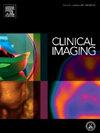在不间断的系统性癌症治疗中对骨、软组织和神经进行冷冻消融
IF 1.8
4区 医学
Q3 RADIOLOGY, NUCLEAR MEDICINE & MEDICAL IMAGING
引用次数: 0
摘要
目的评价接受不间断全身肿瘤治疗的肿瘤患者在伤口愈合方面的安全性。材料和方法在这项单机构irb批准的回顾性研究中,所有患者(29/50(58 %)女性,平均年龄61.9 +/−11.3 岁)在2019年至2022年期间接受骨、软组织或神经冷冻消融治疗以对症治疗,同时接受不间断全身治疗。回顾图表以确定冷冻消融后90 天内的感染或伤口愈合并发症。所有患者均接受常规预防性术中抗生素治疗;术后未给患者开抗生素。结果在不中断32/69(35 %)、26/69(38 %)、14/69(20 %)、5/69(7 %)正在进行的传统化疗、靶向治疗、免疫治疗、研究性临床试验治疗或激素治疗的情况下,分别对骨(42/69,61 %)、软组织(17/69,25 %)和神经(10/69,14 /69,14 /69)进行了69例冷冻消融。中性粒细胞减少(定义为绝对中性粒细胞计数<;1500细胞/mL)患者占3/69(4 %)。已知延迟伤口愈合的药物(如VEGF/R, E/FGFR抑制剂)或慢性类固醇分别在9/69(13 %)和36/69(52 %)中未中断。在冷冻消融之前,治疗区在8/69(12 %)进行栓塞,在34/69(49 %)进行照射。通过平均41 天的临床随访(范围,冷冻消融后1-98 天),没有发生手术部位感染和伤口愈合并发症。结论在本研究中,在不间断的全身治疗下进行经皮冷冻消融术,即使在接受放疗和栓塞治疗的治疗区,也未观察到伤口愈合异常。本文章由计算机程序翻译,如有差异,请以英文原文为准。
Cryoablation of bone, soft tissue, and nerve in the setting of uninterrupted systemic cancer therapies
Purpose
To assess safety of cryoablation in cancer patients receiving uninterrupted systemic cancer therapies with regard to wound healing.
Materials and methods
In this single-institution IRB-approved retrospective study, all patients (29/50 (58 %) female, mean age 61.9 +/− 11.3 years) undergoing cryoablation of bone, soft tissue, or nerve for symptomatic treatment while on uninterrupted systemic therapy between 2019 and 2022 were included for analysis. Charts were reviewed to identify post-cryoablation infection or wound healing complication within 90 days after cryoablation. All patients received routine prophylactic intraprocedural antibiotics; no patients were prescribed antibiotics post-procedure.
Results
Sixty-nine cryoablations of bone (42/69, 61 %), soft tissue (17/69, 25 %) and nerve (10/69,14 %) were performed without interrupting ongoing traditional chemotherapy, targeted therapy, immunotherapy, investigational clinical trial therapy, or hormone therapy in 32/69 (35 %), 26/69 (38 %), 14/69 (20 %), 5/69 (7 %) respectively. There were 3/69 (4 %) patients with neutropenia (defined as absolute neutrophil count <1500 cells/mL). Agents known to delay wound healing (such as VEGF/R, E/FGFR inhibitors) or chronic steroids were not interrupted in 9/69 (13 %) and 36/69 (52 %) respectively. Prior to cryoablation, the treatment zone was previously embolized in 8/69 (12 %) and irradiated in 34/69 (49 %). By mean clinical follow up of 41 days (range, 1–98 days post-cryoablation), no procedure-site infections nor wound healing complications occurred.
Conclusion
Wound healing abnormalities were not observed when performing percutaneous cryoablation with uninterrupted systemic therapies in this study, even in treatment zones that had received radiotherapy and embolization.
求助全文
通过发布文献求助,成功后即可免费获取论文全文。
去求助
来源期刊

Clinical Imaging
医学-核医学
CiteScore
4.60
自引率
0.00%
发文量
265
审稿时长
35 days
期刊介绍:
The mission of Clinical Imaging is to publish, in a timely manner, the very best radiology research from the United States and around the world with special attention to the impact of medical imaging on patient care. The journal''s publications cover all imaging modalities, radiology issues related to patients, policy and practice improvements, and clinically-oriented imaging physics and informatics. The journal is a valuable resource for practicing radiologists, radiologists-in-training and other clinicians with an interest in imaging. Papers are carefully peer-reviewed and selected by our experienced subject editors who are leading experts spanning the range of imaging sub-specialties, which include:
-Body Imaging-
Breast Imaging-
Cardiothoracic Imaging-
Imaging Physics and Informatics-
Molecular Imaging and Nuclear Medicine-
Musculoskeletal and Emergency Imaging-
Neuroradiology-
Practice, Policy & Education-
Pediatric Imaging-
Vascular and Interventional Radiology
 求助内容:
求助内容: 应助结果提醒方式:
应助结果提醒方式:


